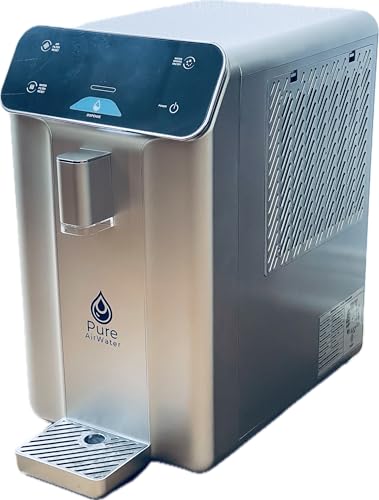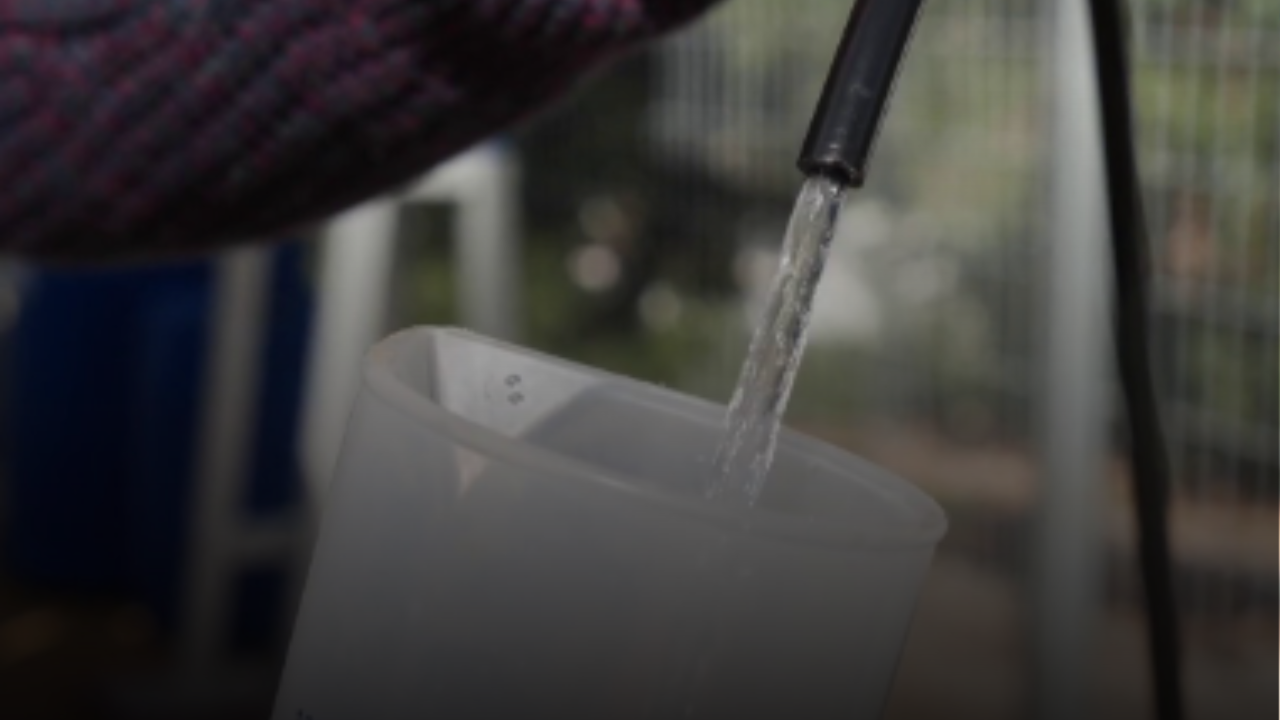To extract water from humid air, you can use atmospheric water generators (AWGs), which cool air to its dew point and then collect the resulting condensation. Condensation-based systems similarly rely on dew point principles but often require high humidity levels for efficiency.
Fog and mist collectors use mesh structures to capture water droplets directly from the air, optimizing design and material to enhance collection efficiency. Alternatively, solar-powered water extraction employs photovoltaic cells, converting sunlight into the energy needed for condensation, even in lower humidity conditions.
Each method offers unique advantages and minimizes environmental impact. Exploring these technologies will reveal further possibilities for sustainable water collection.
Key Takeaways
- Atmospheric Water Generators cool air to collect condensation and provide potable water.
- Condensation-based systems extract water by cooling air below its dew point.
- Fog and Mist Collectors use mesh structures to capture water droplets from the air.
- Solar-Powered Water Extraction uses sunlight to power condensation processes, even in low humidity.
- Biomimetic innovations mimic natural designs like the Namib Desert beetle to enhance water condensation.
Atmospheric Water Generators
How can we harness the abundant humidity in the air around us? Enter the world of Atmospheric Water Generators (AWGs), a nifty solution to the puzzle of water scarcity. These devices aren’t just fancy dehumidifiers; they’re your personal drought busters.
AWGs work by capturing air humidity—yes, that sticky feeling you get on a hot day—and turning it into water. Think of it as milking the air, if you will.
The principle is straightforward: AWGs pull in air, cool it down to reach the dew point, and collect the resulting condensation. This method extracts moisture even from arid environments, where you’d swear the air was as dry as a good martini. The water collected is then filtered and purified, making it safer than your average pond water.
The genius of AWGs lies in their adaptability. They range from small, portable units for your backpacking adventures to large industrial behemoths capable of hydrating entire communities.
In regions suffering from severe water scarcity, AWGs could be less of a gadget and more of a lifeline, providing critical water supplies where traditional sources are either depleted or contaminated. Who knew air could be so quenching?
| # | Preview | Product | Rating | Price | |
|---|---|---|---|---|---|
| 1 |

|
AERstream GW Pro Atmospheric Water Generator – Water from Air Machine for Home & Office,... |
$769.00 |
Buy on Amazon | |
| 2 |

|
Pure AirWater Atmospheric Water Generator A10/Make Water from Air/No Plumbing, No Tap Water... | $1,398.00 | Buy on Amazon |
Condensation-Based Systems
Within the domain of Atmospheric Water Generators, condensation-based systems stand as a cornerstone technology. Let’s explore, shall we? You’re about to get a crash course in the art of coaxing water from air—yes, it’s as magical as it sounds, but with a scientific twist!
At the heart of these systems lies the principle of reaching the dew point—the temperature at which air surrenders its moisture like a flustered criminal in a detective story.
Now, imagine you’re turning the air into a performance artist. First, you cool the air down until it hits its dew point. This is where the magic—ahem, science—happens. As you reduce the temperature, those giddy water vapor molecules in the air suddenly lose their energy, cling together in desperation, and precipitate out in a liquid form. This is condensation at its finest, folks.
The efficiency of this system hinges on two things: the initial humidity levels and the ability to cool the air efficiently. Higher humidity levels mean more raw material (water vapor) to work with, making your job a tad easier. So next time you’re sweating in high humidity, just think: you’re practically standing in a potential goldmine of water!
Turn Air into Water: Secure Your Future with Air Fountain
Fog and Mist Collectors
As you explore the domain of fog and mist collectors, it’s essential to understand the core design principles that govern their functionality. These systems rely on the efficiency of capturing water droplets from the air, which varies considerably based on atmospheric conditions and the materials used. Their application spans across various sectors, particularly in arid regions where traditional water sources are scarce or non-existent.
Design Principles
Most fog and mist collectors utilize a mesh or net structure to efficiently harvest water from the atmosphere. As you explore the world of water extraction, you’ll find that not all meshes are created equal. The design considerations for these structures are as important as deciding between sushi or tacos for dinner—both can satisfy, but the outcomes are quite different!
Material selection plays a pivotal role. Imagine draping your collector with silk, expecting rugged performance—spoiler alert: it won’t end well. Typically, materials like polyethylene or stainless steel are champions due to their durability and corrosion resistance. You wouldn’t wear a paper swimsuit to a pool party, right?
Similarly, choosing the right material for your collector guarantees it doesn’t just give up when the weather throws a tantrum.
The structure’s configuration must also cater to the local climate. It’s like tailoring a suit; it needs to fit just right. The size and shape of the mesh openings aren’t arbitrary decisions. Too large, and you’ll catch less water than a colander holds soup; too small, and you might as well be trying to sieve air.
It’s about finding that sweet spot where science meets ingenuity.
Efficiency and Application
Consider the efficiency of fog and mist collectors, which hinges greatly on their ability to maximize water yield per unit area while minimizing energy consumption and operational costs.
You’re not just catching fog, but you’re doing it with flair and fiscal savvy! Now, let’s explore the cost analysis. These devices are like the economical ninjas of the water extraction world. They operate on the sly, using minimal energy—often just the bare whisper of a fan. It’s all about getting the biggest bang for your buck, or in this case, the most water for your watt.
The environmental impact, you ask? It’s impressively low. Fog and mist collectors are like the silent heroes of ecosystems, capturing water without disturbing the local fauna or flora. They don’t emit greenhouse gases, nor do they require harmful chemicals. It’s nature helping nature, with a little human ingenuity thrown in for good measure.
But don’t let their gentle demeanor fool you. These systems can be tailored to fit a variety of geographical areas—coastal cliffs, mountain ranges, or your backyard.
Each setup is fine-tuned to trap as much moisture as the local air will allow. It’s hydration harvested from thin air—literally!
Dew Harvesting Techniques
Among various innovative methods to extract water from the atmosphere, dew harvesting stands out for its simplicity and efficiency. By capitalizing on the fact that the dew point—the temperature at which air becomes saturated with moisture and releases it as dew—isn’t just a quirky weather term but a nightly water-making fiesta, you can actually harvest this resource.
You see, as the temperature drops to the dew point, moisture traps, fundamentally surfaces designed to cool below the ambient air temperature, become your best pals.
These moisture traps can be as simple as a sheet of metal or a stretch of specialized fabric strategically exposed to the open air at night. The surface cools, flirting with the dew point, and voilà—water begins to condense.
But here’s the kicker: it’s not just about laying out a piece of old metal. The efficiency of your dew harvesting setup hinges on material properties like thermal emissivity and the rate of radiative cooling.
Turn Air into Water: Secure Your Future with Air Fountain
Solar-Powered Water Extraction
Solar-powered water extraction represents a groundbreaking advancement in sustainable technology, directly harnessing the sun’s energy to tackle water scarcity. By tapping into this abundant renewable resource, you’re not just making a toast to the environment but also saying goodbye to unsustainable water sourcing methods. It’s like hitting the eco-friendly jackpot!
These systems use devices powered by photovoltaic cells, which are incredibly efficient at converting sunlight into electricity. Here’s how it rolls: this method leverages solar energy to power devices that condense moisture from the air, even at lower humidity levels.
Imagine a giant sponge powered by the sun, soaking up water vapor from the air—pretty neat, right? The technology advancements in this field have been nothing short of revolutionary, making it possible to efficiently harvest water without the carbon footprint of traditional power sources.
The energy efficiency of these solar systems is through the roof. They utilize photovoltaic cells (think solar panels on steroids) to maximize the conversion of sunlight into electricity, ensuring that every ray of sunshine is put to good use.
The environmental impact? Let’s just say it’s considerably lower than sending trucks to haul in bottled water.
As you explore solar-powered water extraction, you’re not just quenching thirst; you’re drinking in the benefits of sustainable solutions that address water scarcity head-on. Cheers to technology that gives back to the planet!
Biomimetic Innovations in Water Collection
Building on the foundation of solar-powered water extraction, biomimetic innovations offer another promising avenue for addressing global water scarcity.
You’ve seen how nature works with impeccable efficiency, right? Well, scientists are now playing copycat with nature’s designs to develop advanced moisture traps and methods of natural filtration.
Take the Namib Desert beetle, for instance. This little guy can survive in one of the driest places on Earth by condensing fog on its bumpy back—talk about a personal hydration pack! Inspired by this, researchers have created surfaces that mimic these bumps, effectively pulling water from thin air.
You’re not just looking at a cool science experiment; you’re witnessing a potential lifeline for arid communities worldwide.
Now, let’s talk spiders—no, not the creepy crawly kind, but their webs. Ever noticed how dew collects on a web, turning it into a shimmering net of water droplets? Scientists sure did, and now they’re designing synthetic webs as moisture traps. These aren’t your average Halloween decorations, but finely tuned setups that can capture airborne water molecules.
| # | Preview | Product | Rating | Price | |
|---|---|---|---|---|---|
| 1 |

|
Arduino Solar Water Extractor: Tinkercad Arduino Water Generator System (Arduino Tinkercad... | $2.99 | Buy on Amazon | |
| 2 |

|
POPOSOAP 6.5W Solar Fountain Pump for Bird Bath Built-in 3000mAh Battery Backup, DIY Solar Water... |
$29.99
$23.99 |
Buy on Amazon |
Frequently Asked Questions
How Cost-Effective Are These Water Extraction Methods for Household Use?
You’re diving into whether these gadgets are wallet-friendly for home use, aren’t you? Well, the initial investment might make your wallet weep, and the energy consumption isn’t exactly a cheapskate’s dream. Analyzing the numbers, it’s a hefty upfront cost paired with the incessant munching on your power bill.
What Are the Environmental Impacts of Large-Scale Atmospheric Water Extraction?
You’re wondering about the eco-impact of hoovering up atmospheric H2O on a grand scale, huh? Well, buckle up! Large-scale operations can be quite thirsty for energy, which isn’t great for our carbon footprint. Plus, there are sustainability concerns—messing with local climates and potentially depriving ecosystems of much-needed moisture. It’s a bit like using a sledgehammer to crack a nut, environmentally speaking.
Can These Technologies Provide Safe Drinking Water Without Further Treatment?
Absolutely, these technologies can offer safe drinking water, but there’s a catch. You’ll need additional filtration processes to meet safety standards. It’s not just about pulling H2O from thin air; think about dusting off those tiny, unseen particles too! So, while the idea is as invigorating as a morning breeze, make certain you’re not sipping on microbe cocktails. Always double-check those filters—your taste buds and health will thank you!
How Do Seasonal Changes Affect the Efficiency of These Methods?
Seasonal changes greatly impact the efficiency of water extraction. As you’ve noticed, humidity levels and temperature fluctuations play major roles. In summer, high humidity boosts efficiency, but come winter, you’re left high and dry as colder air holds less moisture. So, while you might be dreaming of sipping on air-derived water in July, you’d better have a backup plan when Jack Frost comes nipping at your nose! Keep your humor dry and your water sources diversified.
Are There Any Health Risks Associated With Using Water From Air Extraction?
Steering through water extraction is like solving a Rubik’s Cube; it seems straightforward until you plunge into it. When you pull water from the air, you’re generally safe if you adhere to health standards and guarantee water purity. However, if these standards are neglected, contaminants could pose health risks, much like uninvited clowns at a birthday party. Always check that the system filters and purifies effectively, keeping your health in the clear and humor on your side.
Become Water Independent with the Revolutionary Air Fountain System
Conclusion
An innovative atmospheric water generator can produce up to 500 liters of potable water daily just from air humidity. These technologies, from fog collectors mimicking spider webs to solar-powered systems, are not just scientific marvels but practical solutions combatting water scarcity.
As you explore each method, consider not only the ingenuity behind these designs but also their potential scalability and environmental impact. Embrace these advances as essential tools in our quest for sustainable water resources.




